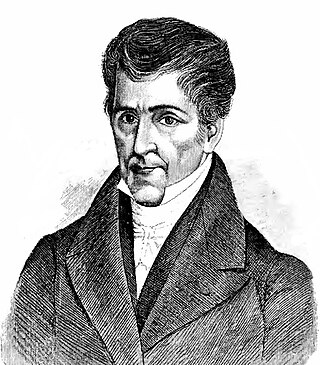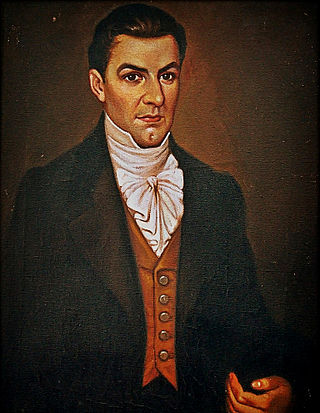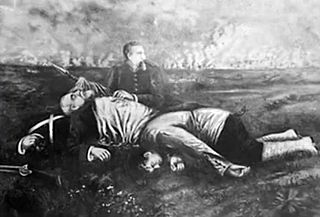
The Federal Republic of Central America, originally known as the United Provinces of Central America, was a sovereign state in Central America which existed from 1823 to 1839. The federal republic was composed of five states: Costa Rica, El Salvador, Guatemala, Honduras, and Nicaragua. The federal republic was bordered to the north by Mexico, to the south by Gran Colombia, and on its eastern coastline by the Mosquito Coast and British Honduras.

José Francisco Morazán Quesada was a liberal Central American politician and general who served as president of the Federal Republic of Central America from 1830 to 1839. Before he was president of Central America he was the head of state of Honduras. He rose to prominence at the Battle of La Trinidad on November 11, 1827. Morazán then dominated the political and military scene of Central America until his execution in 1842.

José Cecilio Díaz del Valle was a philosopher, politician, lawyer, and journalist and one of the most important figures in Central America during the transition from colonial government to independence, displaying a wide-ranging expertise in public administration management.

Manuel José Arce y Fagoaga was a Salvadoran statesman and military officer who served as the first president of the Federal Republic of Central America from 1825 to 1829.

The Greater Republic of Central America, later the United States of Central America, originally planned to be known as the Republic of Central America, was a short-lived political union between El Salvador, Honduras, and Nicaragua, lasting from 1896 to 1898. It was an attempt to revive the failed Federal Republic of Central America that existed earlier in the century.

José Gerardo Barrios Espinoza was a Salvadoran military officer and politician who served as president of El Salvador on three occasions between June 1858 and his overthrow in October 1863.

Andrés del Valle Rodríguez was President of El Salvador from February 1 until May 1, 1876.

Guatemala, officially the Republic of Guatemala, is a country in Central America. It is bordered to the north and west by Mexico, to the northeast by Belize, to the east by Honduras, and to the southeast by El Salvador. It is hydrologically bordered to the south by the Pacific Ocean and to the northeast by the Gulf of Honduras.
The Conservative Party was one of the two major political parties in Guatemala during the nineteenth and early twentieth century. The Conservative Party originated in the Serviles political group—consisting primarily of merchants and estate owners—representing a strong central government and a continuation of the colonial-era privileges. The Conservatives sought to preserve the power and privileges of the Catholic Church, as well as several of the existing monopolies—particularly the tobacco monopoly and the consulado. The Conservative Party consolidated much of their power between 1839 - 1871, mostly during the period under President Rafael Carrera.

Ramón Rosa Soto was a lawyer, journalist, politician and liberal writer of the second half of the nineteenth century. He was the ideologue of educational changes of Liberal Reform in Guatemala and then in Honduras. He served as Principal Minister during the rule of his cousin, Dr. Marco Aurelio Soto and was associated with Soto's mining investments.

The Act of Independence of Central America, also known as the Act of Independence of Guatemala, is the legal document by which the Provincial Council of the Province of Guatemala proclaimed the independence of Central America from the Spanish Empire and invited the other provinces of the Captaincy General of Guatemala to send envoys to a congress to decide the form of the region's independence. It was enacted on 15 September 1821.
General elections were held in the Federal Republic of Central America in 1825 to elect the President of Central America, a post established by the 1824 Central American constitution. The Liberal-dominated Federal Congress called the election, which was held in all five member states; Costa Rica, El Salvador, Guatemala, Honduras and Nicaragua. The two main parties were the Liberals and the Conservatives.
Federal elections were held in the Federal Republic of Central America in 1830. They followed the victory of rebel liberal leader Francisco Morazán in the First Central American Civil War in 1829 when he took Guatemala City. Following the end of the war, Morazán urged Congress for new elections.
Early presidential elections were held in the Federal Republic of Central America on 2 February 1835 following the unexpected death of president-elect José Cecilio del Valle during a journey from his native Honduras and the Federation's capital in Guatemala to take the oath. Valle had been elected in June 1834 and was due to take office in 1835.

The Free State of Costa Rica was the name acquired by Costa Rica after its split from the Federal Republic of Central America in 1838 and until the proclamation of the First Costa Rican Republic in 1847.

The First Central American Civil War was a civil political and military conflict within the Federal Republic of Central America which lasted from 1827 until 1829. The civil war was fought between Liberal and Conservative lines with Francisco Morazán leading the Liberals and Manuel José Arce, a former Liberal, leading the Conservatives.

Barrios' War of Reunification, also known as Barrios' great attempt, was a war initiated by Guatemalan President Justo Rufino Barrios in 1885 with the goal of reunifying Central America. Of the five Central American countries, only Honduras supported Barrios' reunification effort; Costa Rica, El Salvador, and Nicaragua opposed it, as did Mexico.
Guatemalan nationality law is regulated by the 1985 Constitution, as amended in 1995, and the 1966 Nationality Law, as amended in 1996. These laws determine who is, or is eligible to be, a citizen of Guatemala. The legal means to acquire nationality and formal membership in a nation differ from the relationship of rights and obligations between a national and the nation, known as citizenship. Guatemalan nationality is typically obtained either on the principle of jus soli, i.e. by birth in Guatemala; or under the rules of jus sanguinis, i.e. by birth abroad to at least one parent with Guatemalan nationality. It can also be granted to a permanent resident who has lived in Guatemala for a given period of time through naturalization.

The Battle of La Trinidad occurred in Honduras in 1827, during the revolutionary period in Central America between 1811 and 1844.

From January 1822 to July 1823, the Captaincy General of Guatemala, a former Spanish colony, was controlled by the First Mexican Empire, and briefly, the Supreme Executive Power—the provisional government that succeeded Mexican imperial rule. The captaincy general consisted of the provinces of Chiapas, Costa Rica, El Salvador, Guatemala, Honduras, and Nicaragua—the six southernmost provinces of the Mexican Empire. The incorporation of Central America brought Mexico to the height of its territorial extent.















